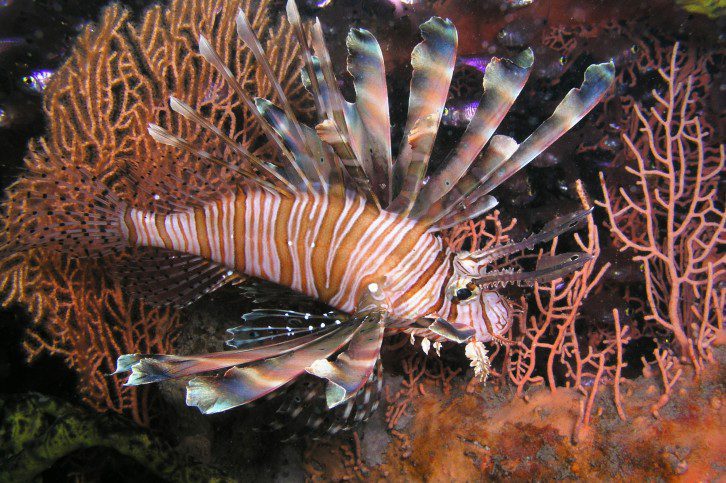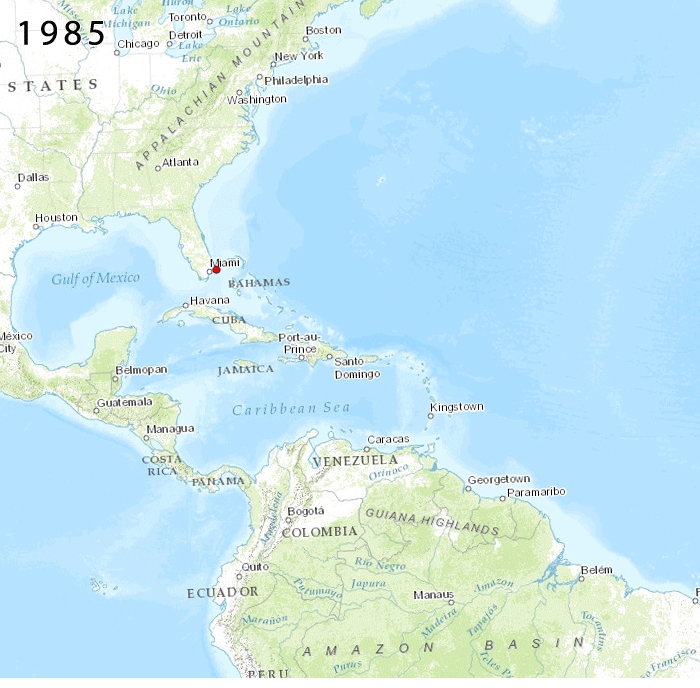The red lionfish (Pterois volitans) is a beautiful fish. In its native range – which extends from the Pacific Islands through the Coral Triangle and into the Indian Ocean to the eastern coast of Africa – to see a lionfish on a dive is considered lucky. There, they rarely grow larger than 20cm, are reclusive during the day, and are found at relatively low densities.

Lionfish are found in low densities in their native range, and like this fish photographed in Madagascar, are a welcome sighting on dives
Not so in the Caribbean, where lionfish were accidentally introduced to the waters of the Florida Keys in the 1980s. In its new environment, the lionfish flourished. Their naïve prey were easy to catch, allowing the predator to grow rapidly and reproduce quickly. The ocean’s currents transported lionfish across the wider Caribbean region, with sightings being reported in new locations with increasing frequency from the early 2000s.

Timeline of the lionfish invasion (from USGS)
They have since become one of the single greatest threats to coral reefs and their associated fisheries. In the Caribbean, where lionfish are bigger and more abundant, they have caused declines of up to 95% in native fish biomass. Their diet is also broader; lionfish are the only known predator to feed on ecologically important parrotfish, reinforcing concerns of the impact this fish will have on Caribbean coral reef health in the long term.
Despite this, invasive lionfish do not eat all fish equally.
“Reef fish that are small and cigar shaped, that are just off the bottom, and that swim alone, are 200 times more likely to be eaten than fish with opposite characteristics.” – Dr. Stephanie Green, 2014, in: Picky Eaters (you can listen to the full audio below).
These characteristics closely match those of the social wrasse (Halichoeres socialis), which is small, cigar-shaped and lives just off the bottom in the shallow coral reefs and mangroves of Pelican Cayes, southern Belize. Found nowhere else in the world and only discovered in 2003, this small fish was already listed as critically endangered on the IUCN Red List due to extensive habitat loss in its tiny, 10 km² range.
Recent research which identified lionfish stomach contents in the Pelican Cayes, revealed that the social wrasse comprises almost half of the lionfish diet in the area. This new and significant threat has led the authors of the study to claim that Belize’s social wrasse might be the world’s most threatened coral reef fish.
![Lionfish dissection [image by JD Toppins]](http://blog.blueventures.org/media/2015/05/Lionfish-dissection-copyright-JD-Toppins-729x483.jpg)
Lionfish dissection to examine the stomach contents [image by JD Toppins]
For the social wrasse, this is good news. Blue Ventures’ lionfish expeditions to Bacalar Chico Marine Reserve, recently listed in National Geographic’s Tours of a Lifetime, have collected data on lionfish populations which is now being used to design surveys in the South Water Caye Marine Reserve – including the Pelican Cayes area. Surveys are scheduled to take place later this year, and the data collected will be used to create tangible management targets and a strategy for lionfish control in this UNESCO World Heritage Site.
We would like to thank MAR Fund for providing the support that makes it possible to conduct these surveys and develop a strategy for control, as well as the Belize Fisheries Department, Lad Akins (REEF) and Dr. Stephanie Green for their valued partnership.
Photo credit for banner image: Gordon Kirkwood (2013)

